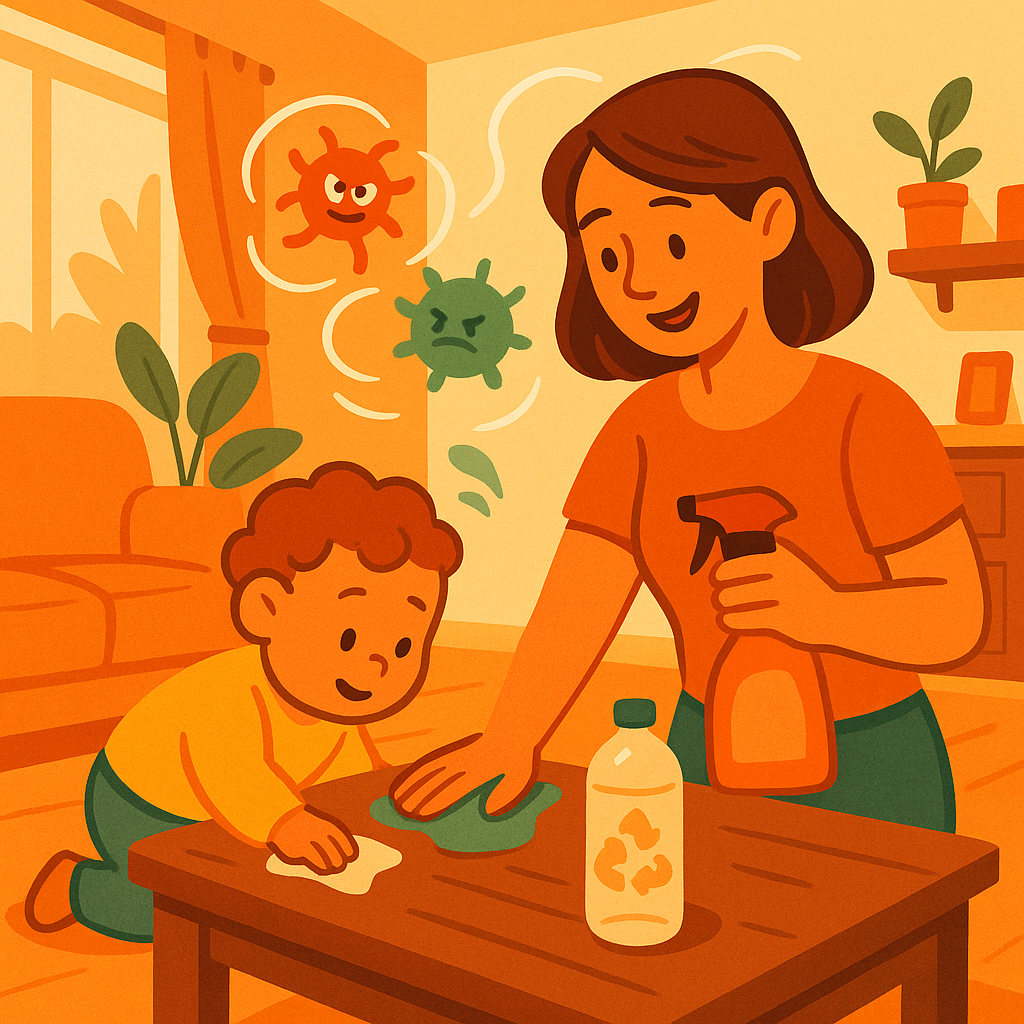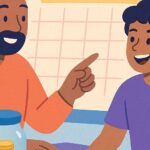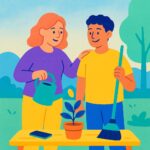### English Version
#### Invisible Invaders: What a New Study Reveals About Toddlers and Toxins
Parents know the drill: your toddler chews on a toy, drops it, licks a spoon, crawls through the kitchen and then puts their fingers straight in their mouth. It turns out that these everyday adventures carry more baggage than we realised. A July 2025 study coordinated by the U.S. National Institutes of Health’s ECHO program tested urine from 201 toddlers in four states and detected **96 different chemicals** in at least five children. Even more unsettling, **48 chemicals were present in more than half of the children**, and **34 were found in over 90 percent** of the youngsters’ samples. Many of these chemicals aren’t routinely monitored and are suspected of disrupting hormones and brain development.
Researchers looked for everyday substances like **phthalates (found in plastics and toys), parabens (in lotions and shampoos), bisphenols (used in food containers), pesticides, flame‑retardant additives and even benzophenones from sunscreens**. They discovered that toddlers can absorb these compounds simply by eating, drinking, breathing indoor air or touching surfaces. The youngest and later‑born children often had higher levels than their older or first‑born siblings, and some minority groups carried more of certain toxins.
#### Why it matters
Early childhood is a critical period for brain and body development. When small bodies are flooded with hormone‑disrupting chemicals, the effects can last a lifetime. That’s why the researchers emphasise that **parents and regulators need to pay attention now**. Although some “legacy” toxins such as triclosan and certain phthalates are declining, replacements like DINCH plasticizer and new pesticides are on the rise.
#### What parents can do
You can’t bubble‑wrap your child, but you can reduce exposure. Here are some simple steps drawn from the study’s recommendations:
1. **Choose safer products:** Look for labels that say phthalate‑free, paraben‑free or fragrance‑free, especially on cosmetics and baby care items.
2. **Ditch the wrong plastics:** Avoid food containers or toys made from plastics labelled #3 (PVC), #6 (polystyrene) and #7 (mixed resins); these can leach bisphenols and other chemicals.
3. **Wash little hands often:** Frequent hand‑washing, particularly before meals, reduces ingestion of contaminants.
4. **Air things out:** Ventilate your home regularly and use HEPA filters if possible.
5. **Eat cleaner:** Thoroughly wash fruits and vegetables to limit pesticide residues and consider organic options when your budget allows.
6. **Clean smarter:** Wipe floors and surfaces with a damp cloth to capture dust that may hold chemical residues.
These tips aren’t about creating fear; they’re about empowerment. Just as we ask our kids to put away toys or help with chores, we can teach them to choose a glass cup over a plastic one or to wash their hands before dinner. Small changes today can safeguard their health tomorrow.
—
### النسخة العربية
#### غزاة غير مرئيين: دراسة جديدة تكشف ما يختبئ في أجسام أطفالنا
يعرف الأهل المشهد جيداً: طفلك يعض لعبة، يقع منها بعض الطعام، يلعق الملعقة، يزحف في المطبخ ثم يضع أصابعه في فمه. اتضح أن هذه الحركات اليومية تحمل أكثر مما نتخيل. دراسة نشرت في يوليو 2025 بالتعاون مع برنامج ECHO التابع لمعاهد الصحة الأميركية فحصت عينات بول من 201 طفلاً. الباحثون اكتشفوا 96 مادة كيميائية مختلفة في عينات خمسة أطفال عل الأقل. الأسوأ أن 48 مادة ظهرت في أكثر من نصف الأطفال، وكانت 34 مادة موجودة في أكثر من 90 % من العينات. كثير من هذه المواد لا تراقب بانتظام ويشتبه في أنها تؤثر على الهرمونات وتطور الدماغ.
العلماء بحثوا عن مواد مستخدمة يومياً مثل الفثالات الموجودة في البلاستيك والألعاب، والبارابين في الكريمات والشامبو، والبيسفينول المستخدم في حاويات الطعام، وكذلك المبيدات الحشرية ومثبطات الاشتعال وبنزوفينونات واقيات الشمس. اكتشفوا أن الأطفال الصغار يتعرضون لهذه المركبات من خلال الأكل والشرب والتنفس أو لمس الأسطح. كما كان الأطفال الأصغر والأبناء اللاحقون يحملون مستويات أعلى من بعض المواد مقارنة بأشقائهم الأكبر، وبعض المجموعات العرقية كانت لديها مستويات مرتفعة.
#### لماذا الأمر مهم؟
الطفولة المبكرة فترة حرجة لنمو الدماغ والجسد. عندما تغمر أجسام صغيرة بمواد تخل بالتوازن الهرموني، يمكن أن تستمر الآثار مدى الحياة. لذلك يؤكد الباحثون أن **على الأهالي والجهات التنظيمية اتخاذ خطوات الآن**. صحيح أن بعض السموم القديمة مثل الترايكلوسان وبعض الفثالات بدأت بالتراجع، لكن البدائل الجديدة مثل مادة DINCH والمبيدات الحديثة في ازدياد.
#### ما الذي يمكن للأهل فعله؟
لا نستطيع تغليف أطفالنا بالفقاعات، لكن يمكننا تقليل التعرض. هذه بعض الخطوات البسيطة الواردة في توصيات الدراسة:
1. **اختيار منتجات أكثر أماناً:** ابحث عن عبارات مثل خالية من الفثالات أو خالية من البارابين أو خالية من العطور، خصوصاً في منتجات العناية الشخصية.
2. **تجنّب بعض أنواع البلاستيك:** ابتعد عن الأوعية والألعاب المصنوعة من البلاستيك رقم 3 و6 و8 لأن هذه الأنواع قد تسرّب مواد كيميائية.
3. **غسل الأيدي باستمرار:** غسل اليدين بانتظام، خاصة قبل الطعام، يقلّل ابتلاع الملوّثات.
4. **تهوية المنزل:** افتح النوافذ بانتظام واستخُم فلاتر هواء عند الإمكان.
5. **تنظيف الأطعمة جيداً:** اغسل الفاكهة والخضار بعناية للحدّ من بقايا المبيدات واختُر المنتجات الأورغانيك إن أمكن.
6. **تنظيف ذكي:** امسح الأرضيات والأسطح بقطعة قماش مبللة لجمع الغبار الذي قد يحتوي على بقايا كيميائية.
هذه النصائح ليست لنشر الخوف، بل لإعطاء القوة للأهالي. كما نطلب من أولادنا ترتيب ألعابهم أو المساعدة في المهام المنزلية، يمكننا تعليمهم اختيار كوب زجاج بدل البلاستيك أو غسل أيديهم قبل الأكل. التغييرات الصغيرة اليوم تحمي صحتهم في المستقبل.
Sources: University of California – Davis Health study on toddler chemical exposure.







Leave a Reply
You must be logged in to post a comment.